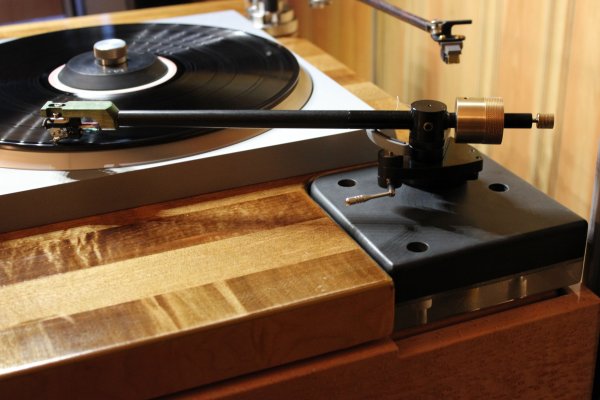What are some sources of coloration caused by the turntable itself, not including the tonearm or cartridge? I have found that the most immediate source is the platter design and material. What are your thoughts on the subject?
Sources of coloration caused by a turntable?
- Thread starter audioarcher
- Start date
You are using an out of date browser. It may not display this or other websites correctly.
You should upgrade or use an alternative browser.
You should upgrade or use an alternative browser.
Bruce B
WBF Founding Member, Pro Audio Production Member
I've heard many times the drive system can be colored..... say for the instance, the save exact TT with Direct, Belt and Rim drive. Maybe it only has to do with noise?
I've heard many times the drive system can be colored..... say for the instance, the save exact TT with Direct, Belt and Rim drive. Maybe it only has to do with noise?
The drive mechanism can vibrate and transfer noise through the turntable and into the cartridge. Direct, belt, rim and idler drive designs all have different challenges in reducing vibration. They can all sound very good or poor depending on the design and effort spent in solving their inherent problems. I think that a lot of the sound difference between the different types of drive is how well they handle turning the platter at the right speed. Again all types can do speed well if designed well. It is not easy or cheap to do so unfortunately.
So lets talk about vibration transfer a little bit. Ideally we want a motor that is smooth and vibrates as little as possible when in motion. I'm not an expert on this but I have read one approach is to use a 3 phase motor and controller. I have seen, and heard it used in two designs that are very good sounding turntables. One is the Ayre's DPS turntable and Steve Dobbins "The Beat". Could be more tables that use this design I'm not sure. Another approach is to use a stretchy belt and locate the motor pod as far away as possible from the rest of the table. The belt will attenuate the vibration, and usually the motor pod will have soft feet to help attenuate vibration as well. I do not like this approach because a stretchy belt will smear detail by stretching back and forth between the platter and motor while turning. Kind of a yo-yo effect. This causes small time variations which smear detail. The best approach is to use the best motor and controller possible first, then there is no need to use band aid fixes to solve the problem. Unfortunately this is very expensive to do and most tables use a very cheap motor.
I like the approach Nottingham Analogue has taken. A very heavy platter combined with their AC motor, which is always ON. You need to push the platter to start its rotation and it literally only takes a second or two to come to speed. Speed accuracy is outstanding and the TT is as quiet as can be from a standard configuration.
I like the approach Nottingham Analogue has taken. A very heavy platter combined with their AC motor, which is always ON. You need to push the platter to start its rotation and it literally only takes a second or two to come to speed. Speed accuracy is outstanding and the TT is as quiet as can be from a standard configuration.
Have no personal experience with Nottingham. How do you stop the platter? Do you just stop it by hand?
Platter material definitely imparts a tonal character/balance. My aluminum platter sounds different than my stainless steel platter. No right or wrong, just voicing preference. I prefer the Stainless platter on the AF1.
Have no personal experience with Nottingham. How do you stop the platter? Do you just stop it by hand?
Yes, you stop it by hand. I'm a big proponent of heavy platters as I believe it truly does increase rotational stability, which might not help with noise, but does play into speed control IMO.
Platter material definitely imparts a tonal character/balance. My aluminum platter sounds different than my stainless steel platter. No right or wrong, just voicing preference. I prefer the Stainless platter on the AF1.
I have found the same. I am using a Technics SP10 mk2a which tolerates heavy platter mats and has a fairly tall spindle. I have around 10 different mats in my collection and have experimented a fair bit. When I do a cartridge change I can usually get better results by experimenting with different mats. Sometimes I use more than one at a time. Right now I'm using a gunmetal Micro Seiki Cu-180 on the bottom and a Clearaudio Vinyl Harmonizer on top, with my Technics EPC 205 mk2L MM cart. I have some soft mats in my collection but never use them as they make the sound too soft for my tastes.
As a "Linnie" I think this is an excellent question. Seems that everything makes a difference, the power supply, the motor, the belt, the suspension, the plinth or lack thereof, the support for the table, the armboard, the subchasssis ( if there is one) AND ON AND ON.
I believe that proper system inertia and freedom extraneous resonance at the vinyl are the keys, and every component in the turntable must do its part for that to happen. It should be a synergistic approach by its very nature.
For example, a lot is said about speed controls, but if the motor cannot adequately control the platter, the world's best speed control unit can't fix it. It may help, but it can't fix a poorly thought out scheme. A wonderful platter on a bad bearing isn't going to work too great, either. And, so it goes.
For example, a lot is said about speed controls, but if the motor cannot adequately control the platter, the world's best speed control unit can't fix it. It may help, but it can't fix a poorly thought out scheme. A wonderful platter on a bad bearing isn't going to work too great, either. And, so it goes.
I believe that proper system inertia and freedom extraneous resonance at the vinyl are the keys, and every component in the turntable must do its part for that to happen. It should be a synergistic approach by its very nature.
For example, a lot is said about speed controls, but if the motor cannot adequately control the platter, the world's best speed control unit can't fix it. It may help, but it can't fix a poorly thought out scheme. A wonderful platter on a bad bearing isn't going to work too great, either. And, so it goes.
Hi Win, can you elaborate on the design of your platter/bearing and motor/controller? I got to hear your Saskia II at RMAF 2013. Very impressive turntable.
Thanks, Sean. I try.
The platter is made from aluminum, brass and Acetron GP (a Delrin variant.) It is center-weighted by the brass with the delrin inset into the top. The goal was to achieve a design that is free from unwanted resonance at the vinyl, as well as one that allows the motor to be in control of the spin. I did not want a flywheel effect that would result in overshoot that would smear micro-dynamics. I was after a spin-neutral design, for the lack of better words.
The bearing was built with reliability being one key factor, and dynamic drag being the other. It is difficult to turn by hand, but the drag is caused by its interaction with the lubricant, not mechanical friction.
The motor is an external rotor, three-phase, eddy current design that has been modified further for turntable use, and the controller is a very sophisticated one that reproduces the power for the motor, plus a bunch of other stuff. It even has linear amps with a total output of 270W. I don't want to promote myself, so I'll stop with that.
The platter is made from aluminum, brass and Acetron GP (a Delrin variant.) It is center-weighted by the brass with the delrin inset into the top. The goal was to achieve a design that is free from unwanted resonance at the vinyl, as well as one that allows the motor to be in control of the spin. I did not want a flywheel effect that would result in overshoot that would smear micro-dynamics. I was after a spin-neutral design, for the lack of better words.
The bearing was built with reliability being one key factor, and dynamic drag being the other. It is difficult to turn by hand, but the drag is caused by its interaction with the lubricant, not mechanical friction.
The motor is an external rotor, three-phase, eddy current design that has been modified further for turntable use, and the controller is a very sophisticated one that reproduces the power for the motor, plus a bunch of other stuff. It even has linear amps with a total output of 270W. I don't want to promote myself, so I'll stop with that.
Last edited:
Thanks, Sean. I try.
The platter is made from aluminum, brass and Acetron GP (a Delrin variant.) It is center-weighted by the brass with the delrin inset into the top. The goal was to achieve a design that is free from unwanted resonance at the vinyl, as well as on that allows the motor to be in control of the spin. I did not want a flywheel effect that would result in overshoot that would smear micro-dynamics. I was after a spin-neutral design, for the lack of better words.
The bearing was built with reliability being one key factor, and dynamic drag being the other. It is difficult to turn by hand, but the drag is caused by its interaction with the lubricant, not mechanical friction.
The motor is an external rotor, three-phase, eddy current design that has been modified further for turntable use, and the controller is a very sophisticated one that reproduces the power for the motor, plus a bunch of other stuff. It even has linear amps with a total output of 270W. I don't want to promote myself, so I'll stop with that.
Sounds like a very well thought out design. Thanks for the info.
We have talked a little about how platters can change the tonality of the sound. How about arm boards? I built the plinth for my SP10 mk2a myself. I have also built 5 different arm boards over the last few years.
My first arm board was a single piece of maple about an inch thick, which I used a Reed 3Q tonearm on. I also had a Reed isolator, which is 2" wide and 1" high. It is made of two pieces of stainless steel with a layer of cork in the middle. So the arm board bolted to the plinth, then the Reed Isolator bolted through the center to the arm board, and the Reed tonearm bolted to the Isolator. Here are few pics of the arm board and plinth in an early stage of construction.
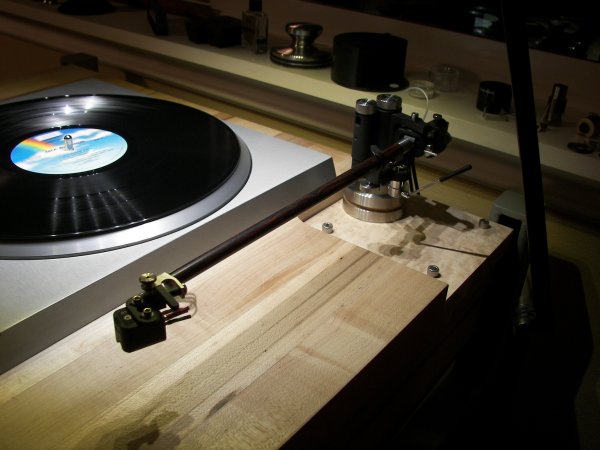
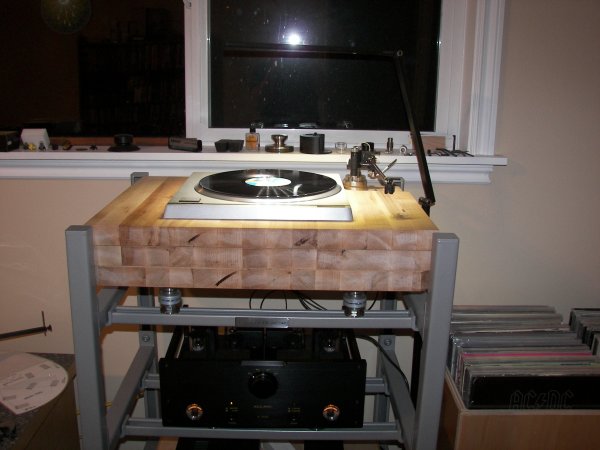
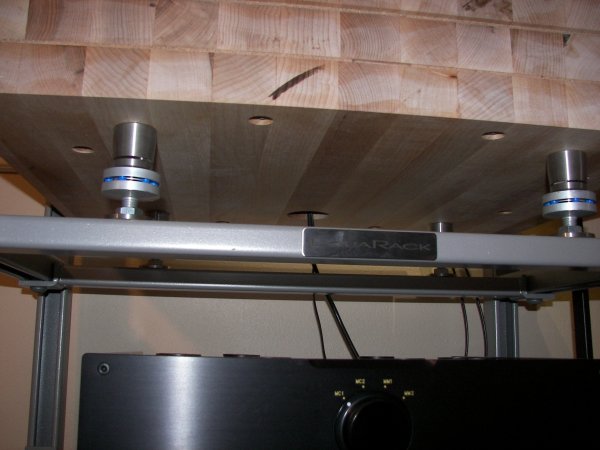
This sounded decent but I eventually decided to try something else.
The next armboard I tried was a solid piece of African Blackwood. Without the Isolator.
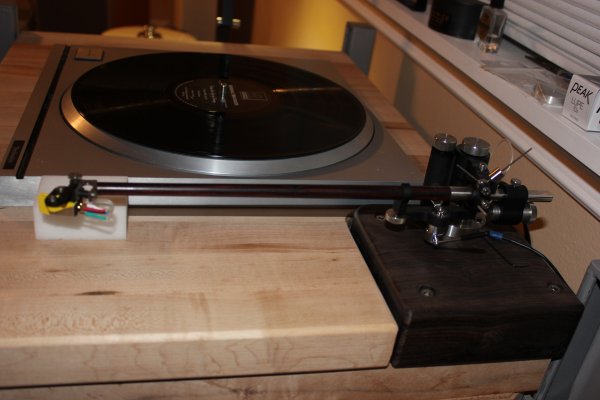
My memory is a bit fuzzy on the sonic changes this brought. It was different but not real significant.
For my next arm board I wanted to try a solid piece of stainless steel. Since the arm board needed to be around 2 inches high that would have been difficult. I ended up ordering 2, 3/4 inch thick plates of SS, and an 1/8 inch thick plate of copper. The SS plates were 10 lbs. a piece when finished! I though about trying to bolt these down to the plinth but that would have required drilling holes all the way through. Not possible with the equipment I had in the garage. So instead I used Isodamp material between the plates and the plinth. The plates were so heavy and the Isodamp very sticky, so it was not going anywhere. Here is a pic of that armboard.
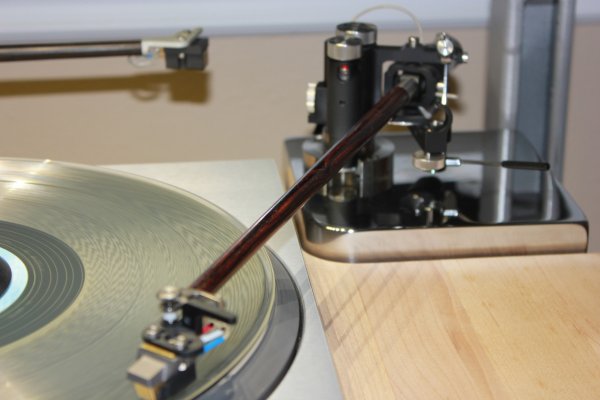
To be continued...
My first arm board was a single piece of maple about an inch thick, which I used a Reed 3Q tonearm on. I also had a Reed isolator, which is 2" wide and 1" high. It is made of two pieces of stainless steel with a layer of cork in the middle. So the arm board bolted to the plinth, then the Reed Isolator bolted through the center to the arm board, and the Reed tonearm bolted to the Isolator. Here are few pics of the arm board and plinth in an early stage of construction.



This sounded decent but I eventually decided to try something else.
The next armboard I tried was a solid piece of African Blackwood. Without the Isolator.

My memory is a bit fuzzy on the sonic changes this brought. It was different but not real significant.
For my next arm board I wanted to try a solid piece of stainless steel. Since the arm board needed to be around 2 inches high that would have been difficult. I ended up ordering 2, 3/4 inch thick plates of SS, and an 1/8 inch thick plate of copper. The SS plates were 10 lbs. a piece when finished! I though about trying to bolt these down to the plinth but that would have required drilling holes all the way through. Not possible with the equipment I had in the garage. So instead I used Isodamp material between the plates and the plinth. The plates were so heavy and the Isodamp very sticky, so it was not going anywhere. Here is a pic of that armboard.

To be continued...
My turntable (Walker), uses a 75 lb lead platter. Rotational inertia is in play here. The low torque motor is coupled to the platter via a belt of silk with fairly high tensile strength and little stretch. Speed is stabilized via the Walker Precision Motor Controller, which is used as an aftermarket unit by many people. Speed changes are done with a toggle on the controller between 33 and 45.
The heavy platter/low torque motor requires a helping hand in getting up to speed and stopping all that mass. I do not turn the motor off when changing LPs. Speed is very steady and has required only minimal adjustment over the years (I check speed accuracy once per week as part of routine maintenance).
The heavy platter/low torque motor requires a helping hand in getting up to speed and stopping all that mass. I do not turn the motor off when changing LPs. Speed is very steady and has required only minimal adjustment over the years (I check speed accuracy once per week as part of routine maintenance).
My turntable (Walker), uses a 75 lb lead platter. Rotational inertia is in play here. The low torque motor is coupled to the platter via a belt of silk with fairly high tensile strength and little stretch. Speed is stabilized via the Walker Precision Motor Controller, which is used as an aftermarket unit by many people. Speed changes are done with a toggle on the controller between 33 and 45.
The heavy platter/low torque motor requires a helping hand in getting up to speed and stopping all that mass. I do not turn the motor off when changing LPs. Speed is very steady and has required only minimal adjustment over the years (I check speed accuracy once per week as part of routine maintenance).
Hi Joe, There is certainly more than one way to skin a cat. Is the platter 100% Lead. If so is there is a coating on it to seal the lead in?
Here are a couple more pics of the SS arm board. At this point I moved the Reed Isolator to the rear to mount my other Reed arm.
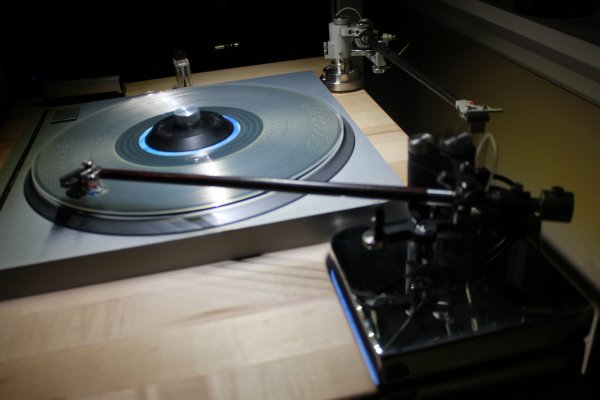
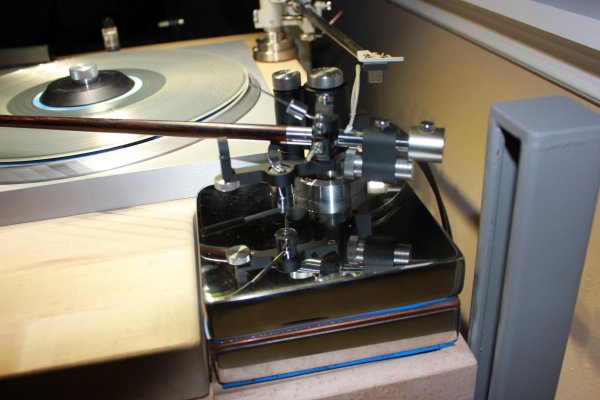
It would have been interesting to hear the difference between using Isodamp and bolting this arm board down to the plinth. It would have required a trip to the machine shop though. Never got around to that.
Next up is the first arm board I made for my Shroder LT. I reused the African Blackwood board, but milled it down some and added 1/4 aircraft aluminum plates top and bottom. I polished the aluminum so it kind looks like SS.
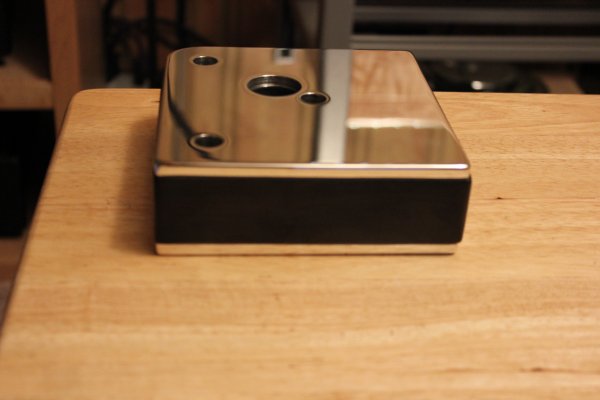
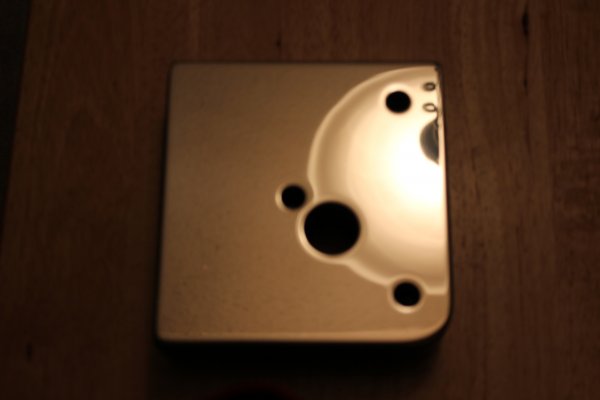
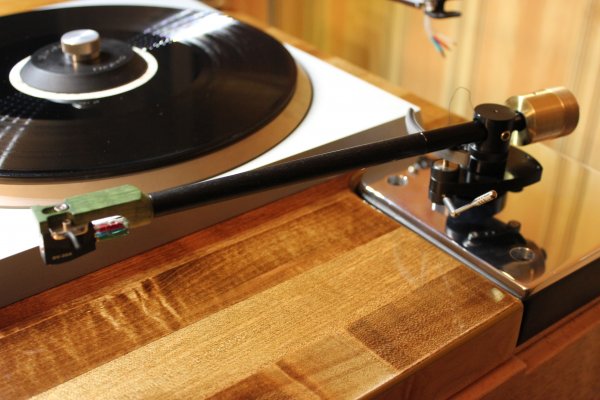
Unfortunately I did not quite get the post hole where I wanted it with this one. It worked but I wanted the arm to point straight ahead when at rest. This turned out to be a blessing though. The next arm board sounded much better.
I talked to Steve Dobbins about it, and he was nice enough to send me a piece of material that he thought would sound best with the Shroder LT. It is a phenolic resin material that some of the arm is made of. I received a 1 inch thick piece, but needed another 3/4" of height. Steve thought that Acrylic would be a good material for the bottom half of the arm board so that is what I used. Here is the latest design. Out of space for pics in this post. See next post.


It would have been interesting to hear the difference between using Isodamp and bolting this arm board down to the plinth. It would have required a trip to the machine shop though. Never got around to that.
Next up is the first arm board I made for my Shroder LT. I reused the African Blackwood board, but milled it down some and added 1/4 aircraft aluminum plates top and bottom. I polished the aluminum so it kind looks like SS.



Unfortunately I did not quite get the post hole where I wanted it with this one. It worked but I wanted the arm to point straight ahead when at rest. This turned out to be a blessing though. The next arm board sounded much better.
I talked to Steve Dobbins about it, and he was nice enough to send me a piece of material that he thought would sound best with the Shroder LT. It is a phenolic resin material that some of the arm is made of. I received a 1 inch thick piece, but needed another 3/4" of height. Steve thought that Acrylic would be a good material for the bottom half of the arm board so that is what I used. Here is the latest design. Out of space for pics in this post. See next post.
Similar threads
- Replies
- 33
- Views
- 1K
- Replies
- 3
- Views
- 972
- Replies
- 11
- Views
- 842
| Steve Williams Site Founder | Site Owner | Administrator | Ron Resnick Site Owner | Administrator | Julian (The Fixer) Website Build | Marketing Managersing |







